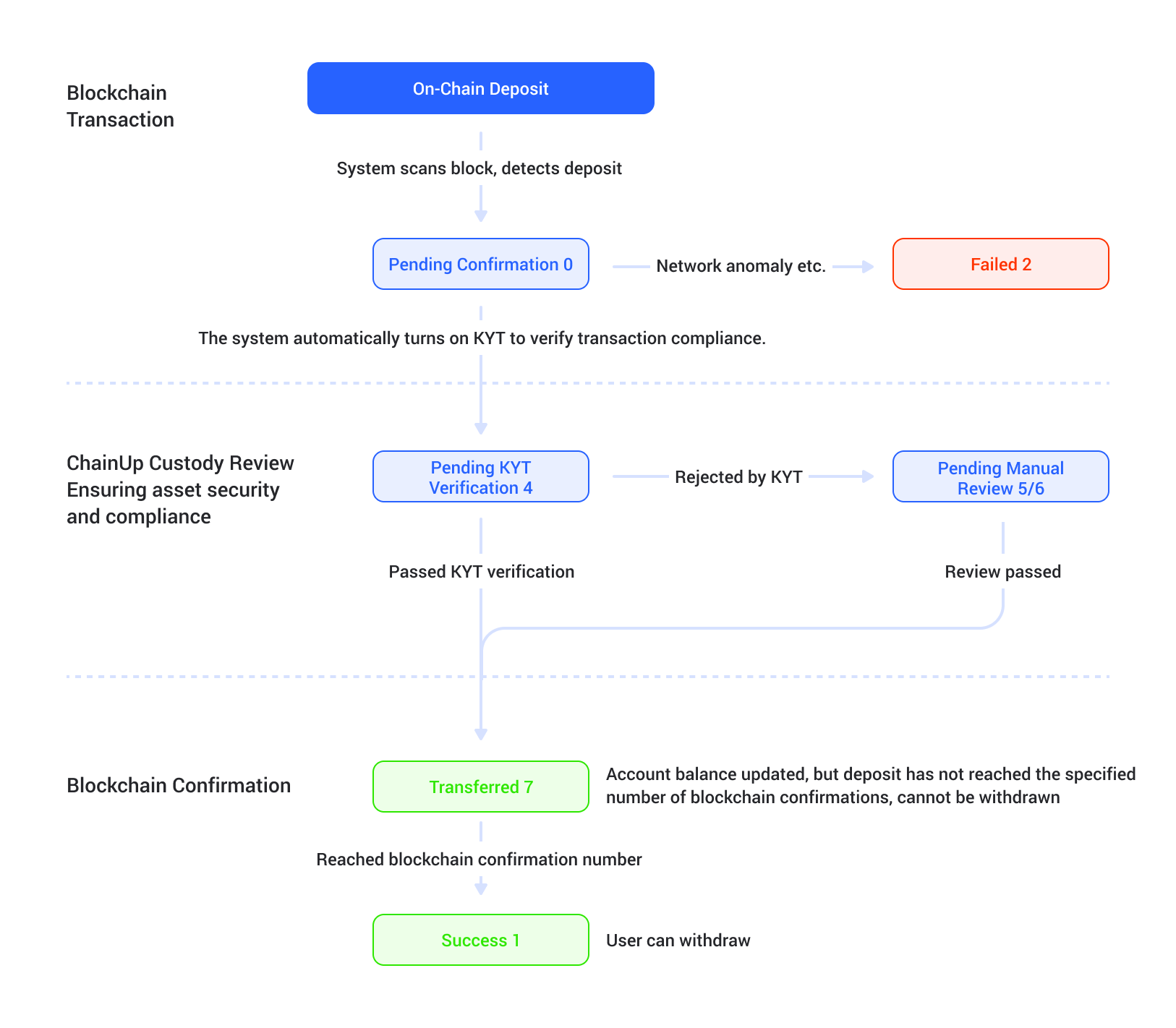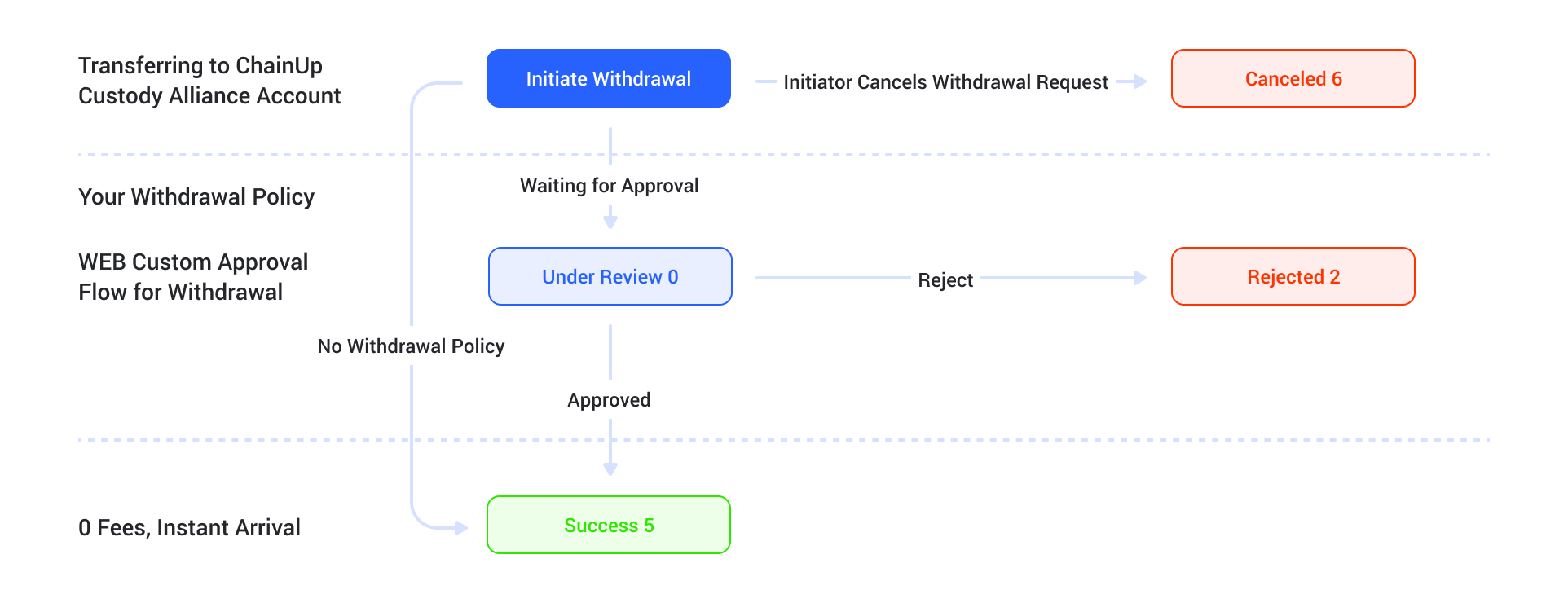Transaction Types and Status
Overview
A transaction refers to the process of transferring value from one address to another. Depending on the processing method and requirements, transactions can be divided into the following two main types:
1. Blockchain Transactions
Blockchain transactions refer to asset transfers conducted on the blockchain network. Specific types include:
- On-Chain Deposit: Users deposit assets from an external address to an on-chain address allocated by the ChainUp Custody Full Custody platform.
- On-Chain Withdrawal: Users withdraw assets from the ChainUp Custody Full Custody platform address to an external address.
- Consolidation: To better manage and custody assets, assets are consolidated to ChainUp Custody Full Custody’s custody address.
Blockchain transactions rely on confirmations from the blockchain network, which may require a certain amount of time and fees. The status of a transaction can be divided into different stages, with each stage having corresponding statuses to detail the current situation and progress of the transaction.
2. Alliance Transfers
Alliance transfers are a fast and economical way to transfer, characterized by:
- Instant Arrival: Since blockchain processing is not involved, alliance transfers can be completed within seconds.
- 0 Fees: Alliance transfers do not require blockchain network fees, thus reducing costs.
Alliance transfers are merely changes at the ledger system level and do not involve actual blockchain transactions.
Applicable scenarios for alliance transfers:
- The transfer address needs to be an alliance address, and
- The mandatory on-chain function is not enabled.
Blockchain Transactions
On-Chain Deposit

Status Description
-
To be confirmed (0): Scanning the blockchain, a deposit transaction from the user is detected, but funds have not yet completed the processing flow.
-
Success (1): The deposit order has been processed successfully, with funds credited and transaction status updated as successful; the user can withdraw these funds at any time.
-
Failed (2): An issue occurred during the deposit process, such as a network problem or system malfunction, and the transaction status is marked as abnormal.
-
Pending KYT verification (4): Based on KYT policies, the deposit transaction is pending KYT service review.
-
Pending manual review (KYT risk level too high) (5): Based on KYT policies, the deposit transaction requires manual review due to a high KYT risk level. The transaction status shows as pending manual review for KYT risk.
-
Pending manual review (KYT Deposit Circuit Breaker) (6): The transaction triggered the system’s KYT circuit breaker mechanism, requiring manual review.
KYT Circuit Breaker Mechanism
If an address has transactions above a certain alert level that remain unprocessed, all subsequent deposit transactions to that address will be automatically set for manual review. For example, if the circuit breaker alert level is set to high risk and a user’s deposit address has three transactions—one at critical alert level and two at low alert level—the circuit breaker will activate, requiring manual processing of all three transactions. Once the critical alert level transaction is resolved and the circuit breaker is lifted, the other transactions will proceed automatically based on their respective alert levels.
- Transferred In (7): Funds have been confirmed as transferred to the wallet but have not reached the required number of confirmations for withdrawal.
Learn more about the Confirmation for different networks.
On-Chain Withdrawal

Withdrawal Miner (Gas) Fees: When users withdraw to a non-alliance address, blockchain transactions incur miner (gas) fees.
Status Description
- Under review by risk control (0): The user has initiated a withdrawal request, and the transaction is now pending internal risk control and ChainUp Custody system review.
- In payment (1): The transaction has completed all confirmation steps (including transaction strategy approval, KYT verification, and system review) and has been successfully signed and broadcasted, awaiting blockchain confirmation.
- Audit rejection (2): This transaction has been terminated and marked as “Audit Rejection” for one of the following reasons:
1.The order did not pass approval or triggered a risk control policy, resulting in a system rejection of the withdrawal request;
2.An abnormality occurred in the transaction, such as network issues or nonce mismatch, leading the system to revoke the transaction.
- Failed (4): If the transaction fails due to blockchain network issues or verification failure during the withdrawal process, the status will update to “Failed.”
- Success (5): The blockchain has processed the transaction, and the withdrawal is successful.
- Cancelled (6): The initiator of the withdrawal has canceled the transaction order, terminating the process and setting the status to “Cancelled.”
- Pending KYT verification (7): The withdrawal request has been submitted but is awaiting review from ChainUp Custody’s internal KYT or wallet-enabled KYT services to ensure compliance and security standards.
- Pending manual review (KYT risk level too high) (8): The withdrawal request has been flagged as a potential risk and requires manual review based on KYT policies. The transaction status is pending KYT manual review.
Consolidation

Consolidation Miner (Gas) Fees: After the user deposits funds to the allocated address, the system automatically transfers the user’s address funds to the system address, incurring this transaction fee.
In a centralized custody system, different types of addresses (such as Account, UTXO, and addresses containing MEMO fields) have some differences in consolidation operations and costs:
- UTXO Type (e.g., BTC) supports multiple inputs in a single transaction, and Memo Type (e.g., XRP) does not require additional consolidation operations and fees.
- Account Type (e.g., ETH and ERC20 Token) requires each transaction to pay miner (gas) fees from the initiating account, so centralized custody platforms need to periodically consolidate funds.
Alliance Transfers
The alliance refers to a group of clients using the Custody system’s blockchain services. Clients within the alliance benefit from fast transfer speeds and zero fees when transferring to each other.
Requires the mandatory on-chain function not to be enabled.

Was this page helpful?